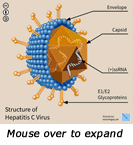The virus
 The hepatitis C virus (HCV) is one of 15 species, in the genus of Hepacivirus, within the family Flaviviridae. The HCV genome is a positive-sense single-strand of RNA (+ ssRNA). The genome is protected by a structural protein capsid. The capsid is enveloped in a host derived lipid endosomal membrane.
The hepatitis C virus (HCV) is one of 15 species, in the genus of Hepacivirus, within the family Flaviviridae. The HCV genome is a positive-sense single-strand of RNA (+ ssRNA). The genome is protected by a structural protein capsid. The capsid is enveloped in a host derived lipid endosomal membrane.
- The membrane has similar lipid components to the very low-density lipoprotein (VLDL) particles that transport cholesterol and fatty acids in the blood. Glycoproteins (E1) and (E2) project from the viral membrane and serve to initiate attachment. The glycoprotein E2 is hypervariable in structure which serves to shield against the host immune system. Low-density lipid receptors on surface of hepatocytes bind to the viral membrane and propel it across and down between the hepatocytes to the tight junction that secures hepatocytes together. When the virus reaches the tight junction, endocytosis begins to draw the virion into the host cell.
- Inside the hepatocyte, the viral nucleocapsid is disassembled releasing the single-strand of viral RNA into the host hepatocyte.
- The single-strand of viral RNA has a positive electrical charge that enables ribosomes on the rough endoplasmic reticulum (ER) of the host to use the (+) ssRNA to assemble and extrude to the interior of the ER a long polyprotein string containing viral components required for replication. The polyprotein string is later cleaved into individual structural and functional proteins ready for assembly.
Positive-sense, single-strand RNA viruses, e.g., HCV, HIV, Influenza A, and SARS-CoV-2, are notorious for their ability to mutate and confound vaccines and treatments. When replicating, HCV's single-strand does not have to match a pyrimidine with a complimentary purine nucleotide on an opposing strand, as does DNA. In RNA replication, one nucleotide can be substituted for another without inactivating replication. A substitution usually results in a protein of a slightly different shape. It is the change in shape that confounds vaccines and drugs by moving the position of binding sites.
Researchers have found that half of the virus's mutations occur in sites that our immune system attacks. As the virus mutates, it changes the location of the binding site that our immune system can recognize. It can then change back to the “ancestral” set of nucleotides. That is, when the virus is under attack, it changes, and then when it's safe, it changes back. Thus, if the virus moves from one host to another, it may lose the mutations that it needed to escape the immune system of the first host, if they aren't needed in the second host. Researchers have found that the mutations are not random, as had been earlier assumed, and the viruses in different people infected by the same ancestral virus have similar genetic elements and mutations. This new information could make it easier to target a vaccine in the future.
Genotype
There are 7 main types (genotypes) of Hepatitis C and there are many subtypes within those genotypes. The dominant genotype globally is genotype 1, which is also associated with more severe liver disease and a much greater risk of developing liver cancer. In the US, genotype 1 accounts for about 60% of cases of HCV. Genotypes 2a, 3b, and 2c account for about 10% of cases in the USA and are most responsive to antiviral medications (Basit, 2021).
Modern approved HCV treatment regimens are directed in part toward the patient's HCV genotype. There are three classes of direct acting antiviral (DAA) medication used in different combinations to form a patient-specific treatment regimen against the various genotypes of HCV (Basit, 2021).
Instant Feedback:
The most common HCV in the USA is genotype 2.
References
Basit, H., Tyagi, I., Koirala, J. (2021). Hepatitis C. [Updated 2021 Jan 24]. In: StatPearls [Internet]. Treasure Island (FL): StatPearls Publishing; 2021 Jan-. Available from: https://www.ncbi.nlm.nih.gov/books/NBK430897/
Hepatitis C Online. https://www.hepatitisc.uw.edu/page/hcv/biology
 The hepatitis C virus (HCV) is one of 15 species, in the genus of Hepacivirus, within the family Flaviviridae. The HCV genome is a positive-sense single-strand of RNA (+ ssRNA). The genome is protected by a structural protein capsid. The capsid is enveloped in a host derived lipid endosomal membrane.
The hepatitis C virus (HCV) is one of 15 species, in the genus of Hepacivirus, within the family Flaviviridae. The HCV genome is a positive-sense single-strand of RNA (+ ssRNA). The genome is protected by a structural protein capsid. The capsid is enveloped in a host derived lipid endosomal membrane.